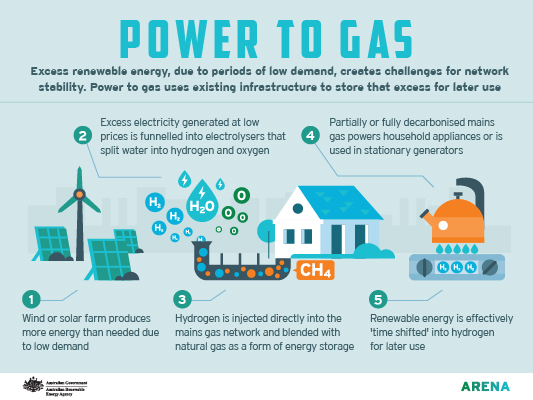How to convert electricity to hydrogen
It’s an innovative device that could see excess renewable energy stored in the existing gas grid and used to decarbonise Australia’s gas supply.

The new class of electrolyser being developed by Wollongong-based company AquaHydrex will produce cheaper hydrogen by splitting water into its two constituent parts. And that hydrogen will most likely have an exciting role to play in Australia’s renewable energy future.
ARENA has provided $5 million in funding to the project, which aims to further develop and commercialise the company’s technology. In partnership with Australian Gas Networks, AquaHydrex will also design and build a pilot plant to trial injecting a small portion of hydrogen into the South Australian gas grid in a process known as “power-to-gas”.
How to convert electricity to hydrogen
Power-to-gas involves converting electricity into hydrogen by splitting water, then inserting the hydrogen into the gas grid, where it mixes with natural gas. The process promises to provide long-term energy storage which helps to stabilise currently-intermittent renewable energy sources like solar and wind. Many experts predict it could be a key plank in addressing storage concerns that presently act as a limitation on how much renewable energy can be used.
ARENA Chief Executive Ivor Frischknecht said this demonstration was the first Australian trial to test ‘power-to-gas’ that will actually result in hydrogen being injected into the gas network.
“Hydrogen can be injected directly into the natural gas network safely at levels of up to 5-10 per cent of the total gas mix, allowing for hydrogen to supplement our gas needs,” Mr Frischknecht said.
“Depending on the material the gas pipeline is made out of, the network can support up to 100% hydrogen in due course, once appropriate regulatory transition and appliance modifications are adopted.”

Huge potential
Currently, renewable energy sources such as wind and solar involve periods of high energy production followed by periods where production dips (for example, there is no wind or sunlight). That instability of supply is less than ideal for the energy system and creates the need for excess renewable energy to be stored for later use. Battery storage, pumped hydro and concentrated solar thermal are all attempts to address this issue. Power to gas has the advantage of using existing infrastructure in a new and creative way to solve the storage problem that can limit renewable energy use.
“There is huge untapped potential in power-to-gas to convert surplus renewable energy to hydrogen and use our existing gas network infrastructure for long-term, safe, reliable energy storage,” Mr Frischknecht said.
The new electrolyser was developed out of research undertaken by scientists and engineers at the University of Wollongong and Monash University.
AquaHydrex Managing Director Paul Barrett said the funding would bring the Australian-developed innovation closer to producing cheap hydrogen at commercial scale.
He said storing renewable energy directly in the gas network was a logical first route to market for the invention.
“Hydrogen has the potential to provide a clean alternative fuel, which if produced efficiently, can be stored in our gas pipelines as well as exported in the future,” he said
AGN Chief Executive Ben Wilson has observed that in line with Energy Network Australia’s recently released Gas 2050 vision, “the volumetric capacity of renewable energy stored in the Australian gas network is equivalent to as much as 6 billion household Li-ion batteries. This provides what is for all intents and purposes a ‘bottomless battery’ that is already in place and capable of storing and transporting vast amounts of time-shifted renewable energy.”
This article was originally written by Daniel Silkstone, former Head of Content, ARENA.
LIKE THIS STORY? SIGN UP TO OUR NEWSLETTER

ARENA